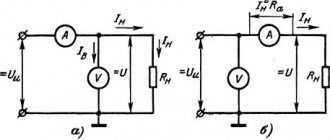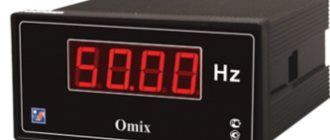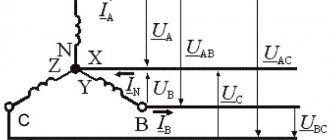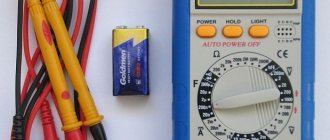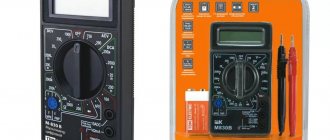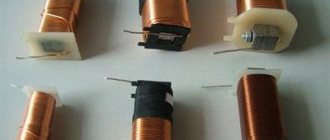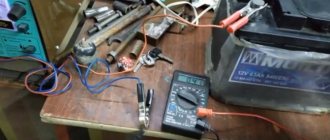Description of the operation of the attachment for measuring small resistances
The entire operation of this attachment is based on measuring the voltage drop across the measured resistance with a known value of the current flowing through it. Transistor VT1 creates a constant current value. Its increased stability is created by the operation of the operational amplifier, which controls the transistor VT1.
Hantek 2000 - 3 in 1 oscilloscope
Portable USB oscilloscope, 2 channels, 40 MHz….
More details
The value of direct current at the time of measuring resistances up to 20 Ohms is -10 mA and 100 mA when measuring up to 2 Ohms. To increase the stability of the entire circuit, the DA1 chip, in turn, is powered by a 78L05 (DA2) stabilizer. Switch SA1 selects the measurement limit. Button SA3 is pressed only when measurements are taken. To protect the voltmeter from damage when the meter is turned on without a resistor, a diode VD1 is added to the circuit.
Analogue low resistance meter
You can assemble not just a console, but a ready-made independent device. This analog milliohmmeter uses two resistance measurement modes. At a stable current of 1A (scale 1 division = 0.002 Ohm) and at a stable current of 0.1A (scale 1 division = 0.02 Ohm). This is for the head shown in photo 1. As can be seen from the photo, the measuring head has a total deviation current of 100 μA. The price of a small division is 2 µA. At a current of 0.1A, the device will measure resistance from 0.02 Ohm to 1 Ohm. Those. the deviation of the arrow by the last division of the scale will correspond to one Ohm.
Schematic diagram of a milliohmmeter
The principle of operation of the device is to measure the voltage drop across the measured resistance when a certain stable current passes through it. The frame resistance of the pointer measuring device is 1200 Ohms, the total deviation current is 0.0001 A, which means that if we use this indicator as a voltmeter, we will need to apply a voltage to it of the value U = IxR = 0.0001x1200 = 0.12 V = 120 mV to deflect the needle to the last scale division. This is exactly the voltage that should drop across a resistance of 1 Ohm at the measuring limit of the device from 0.02 Ohm to 1 Ohm. This means that at this measurement limit we need to pass a stable current of magnitude I = U/R = 0.12/1 = 0.12A = 120 mA . The same can be calculated for another limit.
Instrumentation Forum
Set-top box calibration
First, the handles of variable resistors R2 and R5 must be set to the middle positions. Next, a voltage of 8...24 V is supplied to the console. The constant value of the current flowing through the resistance being measured can be set in 2 ways.
The first method will require the use of a high-precision milliammeter. It is necessary to connect its probes to the terminals of the low resistance being measured. Move the switch of the SA1 attachment to the position for measuring resistance up to 2 Ohms (upper in the diagram), and set the range on the milliammeter to 200 mA. Then you need to press the SA3 button and, by changing the resistance of the variable resistor R5, set the current to 100 mA.
Next, set switch SA1 to the position up to 20 Ohms (lower in the diagram), and set the milliammeter level to 20 mA. Press the SA3 button and use resistor R2 to set the current to 10 mA. Repeat this method of current calibration several times, and then cover the variable resistor sliders with varnish or paint.
The second calibration method is to use standard resistances of 1 and 10 ohms. By changing the resistance of the resistors in each range, set the voltage drop across the standard resistors to 100 mV.
In this set-top box you can use an operational amplifier LM324 or K1401UD2A. The 78L05 stabilizer can be replaced with K142EN5A, the BD135 transistor can be replaced with KT815, KT817, and the diode with KD103A. Transistor VT1 must be placed on a small radiator. To connect the low-resistance resistor being measured, it is convenient to use alligator clips. Particular attention should be paid to the method of connecting the voltmeter probes. They must be connected directly to the terminals in which the resistance being measured is located - in this case, the resistance of the probe wires will not affect the measurement results.
Attachment for measuring small resistances with a multimeter. Scheme
This is a simple attachment that fits most digital multimeters. The device allows you to measure small resistances (<100 ohms) with a resolution of 0.01 ohms. The circuit is powered from a stabilized source with a voltage of 4...9 V. The range of measured resistance depends only on the measurement range and resolution of the voltmeter in a given multimeter.
Transistor tester / ESR meter / generator
Multifunctional device for testing transistors, diodes, thyristors...
More details
Currently, multimeters most often have measuring ranges of 200/400/600 mV with a resolution of 0.1 mV. This allows resistance measurements up to 20/40/60 ohms with a resolution of 0.01 ohms. Most multimeters for measuring resistivity in the 200/400/600 ohm range use a 1 mA DC current that flows through the resistance being measured, Rx.
As this current flows through resistance Rx, a voltage drop Vx occurs, which is directly proportional to the value of this resistance. According to Ohm's law:
Vx = Rx * Ix [V]
Rx = Vx / Ix [Ohm]
Increasing the resolution of resistance measurements in the lowest range can be achieved in two ways.
The first way is to use a millivoltmeter with an increased measurement resolution of up to 0.01 mV, which, unfortunately, is not easy and is rarely used in practice.
The second way is to increase the measuring current Ix, and this solution is used by this adapter. This current value is not used in common multimeters, since in most cases there is no need to accurately measure resistance with a resolution of 0.01 ohms, and, in addition, measuring with a current of Ix = 10 mA will reduce the battery life of the multimeter.
The basis of the set-top box is the popular voltage stabilizer LM1117, which works as a current source. The constant output current Iout depends on the reference voltage Vref and LM1117 on the resistance Rz connected between its ADJ and OUT pins. The value of this current can be calculated using the formula: Iout = Vref / Rz [A].
The reference voltage Vref depends on the type of LM1117 and is 1.225...1.27V, as a rule, it is 1.25 V. Resistor R1 together with resistors R2...R5 connected in parallel form a resistance Rz = 124...126.25 Ohms (taking into account the tolerance 1%), typically 125 ohms. The resulting output current Iout is 9.7...10.24 mA (taking into account the Vref range and 1% resistor tolerance), usually this value is very close to 10 mA.
The accuracy of the measurements of the tested resistance Rx depends mainly on the value of this current (ideal value Iout = 10.00 mA), but also on the accuracy of the millivoltmeter measurement in the multimeter itself.
source
Power supply 0…30 V / 3A
Adjustable power supply assembly kit…
More details
Measurement of small resistances, shunts
I suggest using a bridge measurement circuit for this purpose. Everyone should understand what a bridge is; we won’t dwell on that. Let's make a bridge of resistors, apply some voltage to it and measure it, although we can also measure the current, it won't make a difference; we choose what is more accurate at hand. So what does low resistance measurement have to do with it? Patience, everything is in order from afar. There is such a wonderful thing as bridge balance. The product of the resistances of the opposite arms of the bridge, provided it is balanced, will be the same. And voltages and currents, when the bridge is balanced, will cancel each other out and give a total of 0.
(Let R0 be R3 and Rx be R4)
So, based on the above, if instead of one of the resistors we put our small resistance of an arbitrary value in the bridge, and make the other resistor variable or tuning (according to the diagram, we use two variable resistors to accurately balance the bridge, especially in the case when there are no multi-turn variables at hand resistors) to achieve bridge balance. This circuit can be used to measure shunts and small resistances:
It was lazy to assemble the circuit, especially since it takes a lot of time to make the board, so an experimental sample of the circuit was made by hanging installation. Here, resistors R1 and R2 are not 1%, but they were selected as close as possible to the resistance of a given value, the resistance error did not exceed 0.5% at room conditions.
But you need to know how to get the exact value of the measured resistance. Firstly, the main feature of such a circuit is that it “multiplies” the measured resistance. This means that there is no need for a milli-ohm scale in a multimeter. A resistance of 0.1 Ohm can already be measured on a kilo Ohm scale. Only the measurement will now be not direct, but indirect; you will have to use a little mathematics and calculate the final result of the measurement.
Let's decide what range of ratings we will measure (meaning low resistance or shunt resistance). To do this, you need to select the values of the variable resistors:
According to the circuit, we use two variable resistors for greater interaction accuracy, 1 kOhm and 100 Ohm. This resistance of variable resistors will allow you to measure the maximum resistance of 1.1 ohms, the minimum while maintaining measurement accuracy of 0.01 ohms (with Rx = 0.01 ohms R0 should be 10 ohms, which also need to be measured quite accurately with your multimeter)
And the values of constant resistors, so that the bridge can be easily balanced and it is convenient to calculate the value of the shunt or small resistance:
Let's put together a diagram. You can use any tuning or variable resistors, but for greater accuracy I advise you to take multi-turn tuning or variable resistors, and use constant ones with a tolerance of no more than 1%, or better yet, even less. The circuit uses a 9-volt Krona as a battery; it can be replaced with any other source. Capacitors in case of using power supplies for filtering. The circuit in our resistance configuration consumes 90 mA from a 9 V battery, so for frequent measurements, of course, it is more advisable to use a power supply. The circuit has been assembled, now we are studying the measurement technique. After connecting the measured resistance, it is necessary to apply voltage to the circuit, no matter what, but the higher it is, the greater the accuracy, set the meter to the limit of 200 mV and begin the process of balancing the bridge by rotating the trimming resistor until full zero appears on the voltmeter. This means that the bridge is balanced and all expressions are now valid for our circuit. Next, we measure the resistance of the tuning resistor and calculate the value of the small resistance:
or more beautifully like this
(219 Ohm * 100 Ohm)/100 kOhm we get 0.219 Ohm shunt resistance (see video).
Now you won’t have to rack your brains when the need for such measurements arises. The scheme is simple, but not many people know about it.
Attached to the article is a printed circuit board for making a mini multimeter attachment and a Proteus project for those curious to check out this miracle, but lazy to assemble the circuit.
Source
Do-it-yourself device for measuring small resistances
In the practice of radio amateurs, one encounters the need to measure low-resistance resistances (up to 1 ohm). A simple milliohmmeter is designed to solve this problem. This device can measure resistance from 0.0001 to 1 Ohm with sufficient accuracy for a radio amateur. When measuring small resistances using digital multimeters in series with the measured resistance, let's call it Rx, the resistance of the connecting wires, the transition resistance of the input terminals or sockets, switch contacts, etc. are inevitably included. This resistance (Rpr.) is in the range of 0.1...0.4 Ohm. Due to the above reasons, the actually measured resistance will be greater than Rx by a certain amount (Rx+Rpr.). The error can reach up to 50% when measuring very small resistances. For large resistances this error is small and can be ignored. From the above it is clear that it is necessary to exclude the influence of connecting wires, etc. on the result of measuring very small resistances. There is a method for measuring low resistance using a 4-clamp DC circuit. The use of this method completely eliminates the influence of connecting wires on the result of measuring small resistances. This method is used in this milliohmmeter. Let us briefly consider the essence of the 4-clamp measurement method.
